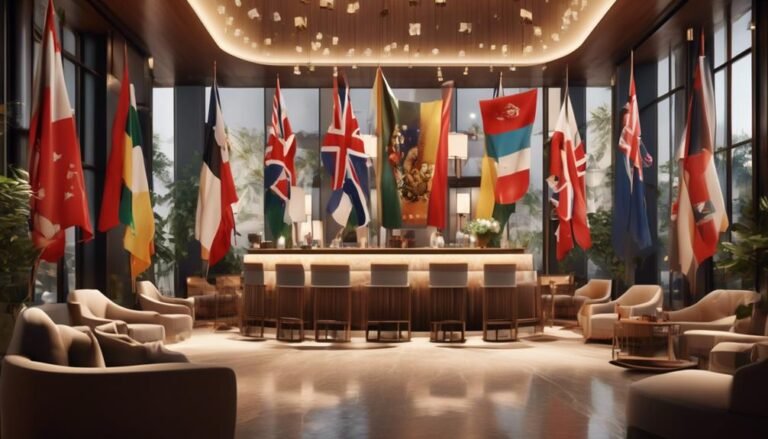Creating Inclusive Environments in Tourism
To create inclusive environments in tourism, there are several key steps that need to be taken.
First and foremost, it is important to understand diverse customer needs. This means recognizing and acknowledging the different requirements and preferences of travelers from various backgrounds, including those with disabilities, different cultural beliefs, and unique personal circumstances.
In addition to understanding these needs, providing accessible accommodations and facilities is crucial. This involves ensuring that all customers, regardless of their physical abilities, can easily access and use the amenities and services provided. This includes, but is not limited to, accessible rooms, ramps, elevators, and properly equipped bathrooms.
Another important aspect of creating inclusive environments in tourism is offering culturally sensitive experiences. This means designing and providing activities and experiences that are respectful and considerate of different cultural beliefs, practices, and traditions. It involves avoiding stereotypes and ensuring that all customers feel valued and respected in their cultural identity.
Furthermore, inclusive marketing and representation play a significant role. It is essential to showcase diversity and inclusivity in all marketing materials, including advertisements, brochures, and websites. This ensures that potential travelers can see themselves represented and feel encouraged to choose your destination or services.
Training your staff for inclusivity is also crucial. This involves providing comprehensive training programs that educate employees on how to effectively communicate and interact with customers from diverse backgrounds. It includes topics such as cultural sensitivity, disability awareness, and inclusive language.
Lastly, collaboration with local communities is essential. Engaging with local communities and involving them in decision-making processes helps ensure that their unique perspectives and needs are taken into account. This can include partnering with local organizations and businesses that specialize in inclusivity, as well as seeking input and feedback from community members.
By following these steps and going beyond meeting requirements, you can foster a sense of belonging and respect for all travelers. This creates inclusive environments in tourism that truly cater to the diverse needs and preferences of all customers.
Key Takeaways
- Recognize and acknowledge different requirements and preferences of travelers from various backgrounds
- Ensure rooms and facilities are accessible for all guests
- Offer opportunities for cultural immersion
- Craft inclusive messaging that welcomes individuals from all backgrounds
Understanding Diverse Customer Needs
Understanding the diverse needs of your customers is essential for creating an inclusive and welcoming environment in the tourism industry. Cultural awareness plays a pivotal role in meeting these needs. By understanding and respecting the cultural differences of your customers, you can tailor your services to provide a more personalized and satisfying experience, ultimately leading to higher customer satisfaction.
To achieve this, it's crucial to invest in cultural awareness training for your staff. This will enable them to interact with customers from different cultural backgrounds in a respectful and understanding manner. Encouraging open communication and feedback from both customers and employees can also help in gaining insights into the specific needs and expectations of diverse customer groups.
Moreover, embracing cultural diversity in your marketing strategies and service offerings can signal to customers that their needs are valued and catered to. By integrating cultural elements into your services, you can create a more inclusive environment that resonates with a wider customer base, thereby enhancing customer satisfaction and loyalty.
Accessible Accommodations and Facilities
When creating inclusive environments in tourism, it's crucial to consider the accessibility of accommodations and facilities.
Ensuring that rooms are accessible and facilities are adapted for diverse needs is essential for providing a welcoming experience to all guests.
Room Accessibility
Ensuring accessible accommodations and facilities is essential in creating an inclusive environment for all guests in the tourism industry. Accessible design and universal design principles should be applied to room accessibility to provide barrier-free environments. Room modifications and disability accommodations are crucial for accommodating guests with diverse needs.
Accessible facilities and inclusive architecture contribute to creating a welcoming space for everyone. Incorporating mobility solutions into accommodation accessibility ensures that individuals with varying levels of mobility can navigate the space comfortably. It's essential to consider accessible room features such as wider doorways, grab bars, and adjustable amenities.
Facility Adaptations
You can enhance the accessibility and inclusivity of your facilities by implementing thoughtful adaptations to accommodate diverse guest needs. Adapting facilities to be more inclusive isn't only the right thing to do, but it also significantly contributes to customer satisfaction and the overall customer experience.
Here are some key points to consider when making facility adaptations:
- Inclusive Design: Implementing inclusive design principles ensures that your facilities are accessible to all guests, regardless of their physical abilities.
- Consider installing ramps, handrails, and elevator access to make all areas of your facility easily reachable for guests with mobility challenges.
- Provide accessible parking spaces and ensure that pathways are wide enough for wheelchair users to navigate comfortably.
It is crucial to prioritize these adaptations to create a welcoming environment for all guests, ultimately leading to higher customer satisfaction and loyalty.
Culturally Sensitive Experiences
How can we ensure that tourists have culturally sensitive experiences that respect and honor the local customs and traditions?
Achieving this requires a strategic approach that promotes cultural immersion and respectful interactions.
To begin with, offering opportunities for cultural immersion can enhance the authenticity of the tourist experience. This could involve organizing activities such as traditional cooking classes, art workshops, or visits to local festivals, allowing visitors to engage with the community and gain a deeper understanding of the local way of life.
Additionally, it's essential to encourage respectful interactions between tourists and the local population. This can be achieved by educating visitors about cultural norms and customs, promoting open-mindedness, and emphasizing the importance of showing sensitivity and respect towards the local traditions.
Providing guidelines or orientation sessions for tourists before they engage with the local community can also be beneficial in fostering understanding and empathy.
Inclusive Marketing and Representation
To foster a truly inclusive environment in tourism, it's important to ensure that marketing and representation reflect the diverse cultures and traditions of the destinations, welcoming and celebrating visitors from all backgrounds. When it comes to inclusive marketing and representation in tourism, consider the following:
- Inclusive Messaging: Craft marketing materials and campaigns that use language and messaging that's welcoming to all individuals, regardless of their background. Avoid assumptions about your audience and strive to use inclusive language that embraces diversity.
- Diverse Imagery: Incorporate a wide range of diverse imagery that accurately represents the people who visit and inhabit the destinations. Showcasing a variety of ethnicities, ages, abilities, and gender identities in your marketing materials can help all visitors feel seen and welcome.
- Authentic Representation: Work with local communities and businesses to ensure that the representation of the destination is authentic and respectful. This can involve featuring local voices, traditions, and stories in your marketing materials to provide a genuine and inclusive portrayal of the destination.
Training Staff for Inclusivity
To create an inclusive environment in tourism, it's important to provide sensitivity training for your staff, ensuring they understand the needs and experiences of diverse customers.
Encouraging open communication and active listening can also help your team better serve all visitors, regardless of their backgrounds.
Sensitivity Training for Staff
Wondering how to ensure that your staff is trained to create an inclusive environment for all visitors? Sensitivity training for staff is crucial in fostering staff empathy and customer understanding. Here are some key points to consider:
- Staff Empathy and Customer Understanding
Encourage staff to put themselves in the shoes of the visitors, understanding their diverse backgrounds and needs.
Provide training on active listening and effective communication to ensure that staff can empathetically respond to the varying requirements of visitors.
- Sensitivity Awareness and Cultural Competence
Offer workshops on cultural competence and sensitivity awareness to equip staff with the knowledge and skills needed to interact respectfully and inclusively with visitors from different cultural backgrounds.
Communication With Diverse Customers
Ensuring effective communication with diverse customers is essential for creating an inclusive environment. Training your staff to do so is a strategic and empathetic approach to meeting the needs of all visitors.
Language interpretation and cultural competence are crucial in accommodating diverse customers. Provide resources for language interpretation, such as multilingual staff or translation services, to ensure that language barriers are overcome.
Additionally, cultural competence training can help staff understand and respect the cultural differences of customers, leading to more meaningful interactions.
Non-verbal communication and visual aids can also enhance communication with diverse customers. Encourage your staff to use gestures, facial expressions, and visual aids to supplement verbal communication. This ensures that all customers, regardless of language or cultural background, feel welcomed and understood.
These strategies won't only improve customer satisfaction but also showcase your commitment to inclusivity.
Collaborating With Local Communities
Engaging with local communities is essential for creating a truly inclusive and enriching tourism experience. By fostering community engagement and forming local partnerships, you can ensure that your tourism initiatives are respectful, sustainable, and beneficial for everyone involved.
Here are three key strategies for collaborating with local communities:
- Establishing Open Communication: Initiate open and transparent communication channels with local community leaders and members. Actively listen to their needs, concerns, and ideas to co-create tourism experiences that are mutually beneficial.
- Empowering Local Participation: Encourage local community members to actively participate in tourism activities, whether it's through cultural performances, storytelling, or artisanal workshops. This not only enriches the visitor experience but also provides economic opportunities for the community.
- Respecting Local Traditions and Customs: Prioritize the preservation of local traditions and customs in tourism activities. This involves understanding and respecting cultural sensitivities, engaging in responsible tourism practices, and contributing to the preservation of local heritage.
Conclusion
In conclusion, creating inclusive environments in tourism is like planting seeds in a garden – with care and attention, it will blossom beautifully.
Understanding diverse customer needs, providing accessible accommodations, offering culturally sensitive experiences, and inclusive marketing are all essential.
Training your staff for inclusivity and collaborating with local communities will help ensure that everyone feels welcome and valued.
By embracing diversity and making everyone feel included, you can truly cultivate a flourishing and vibrant tourism experience for all.





